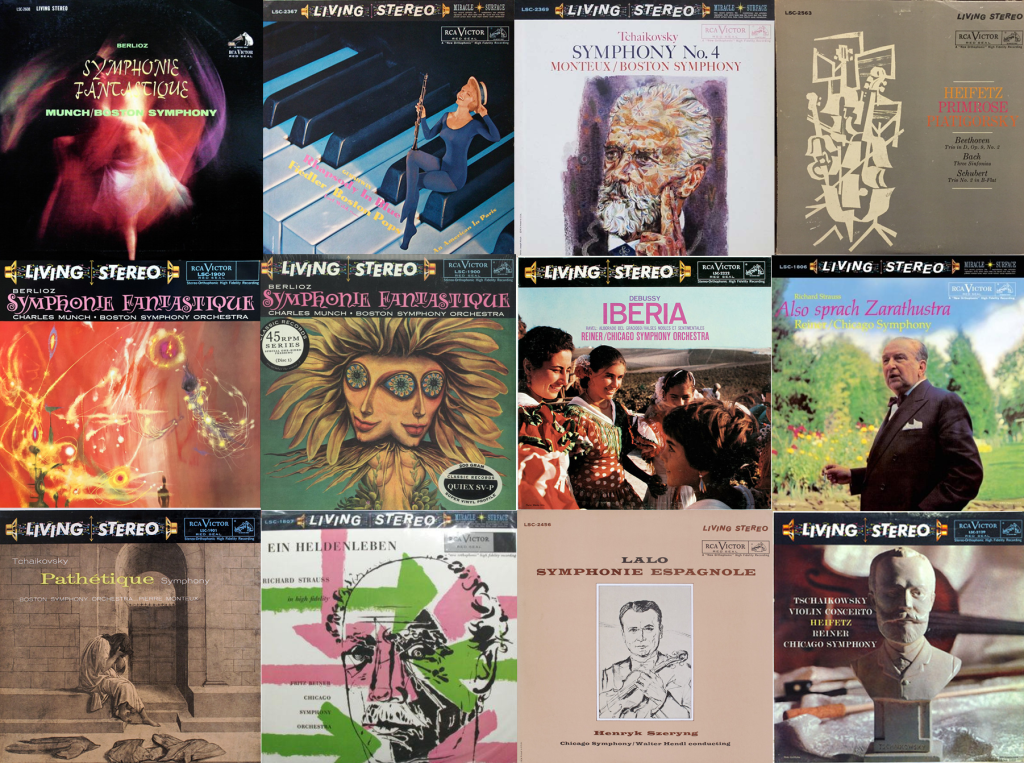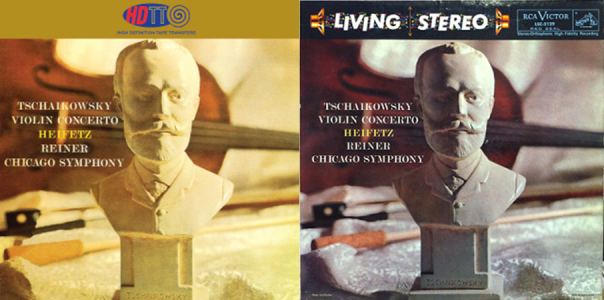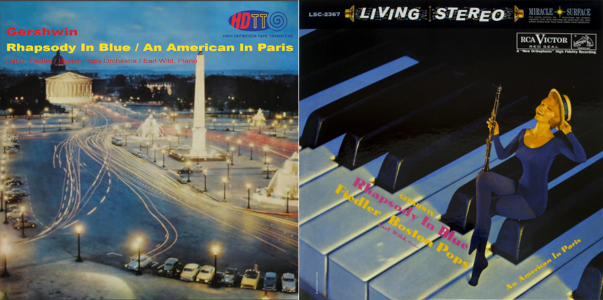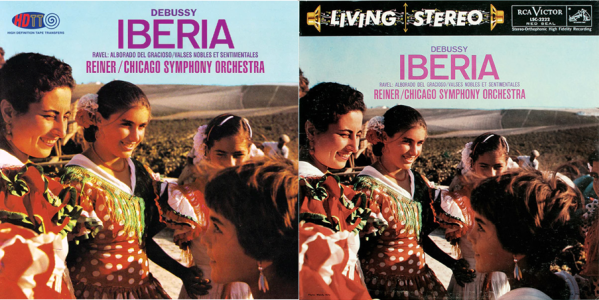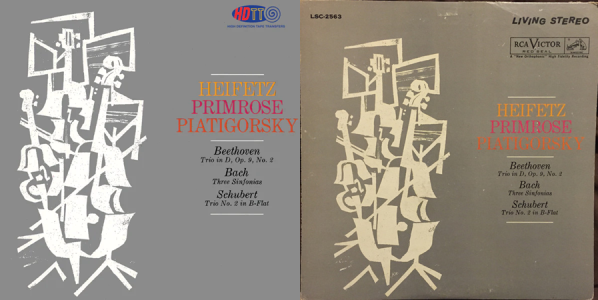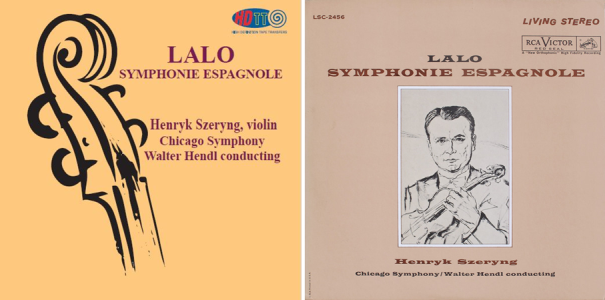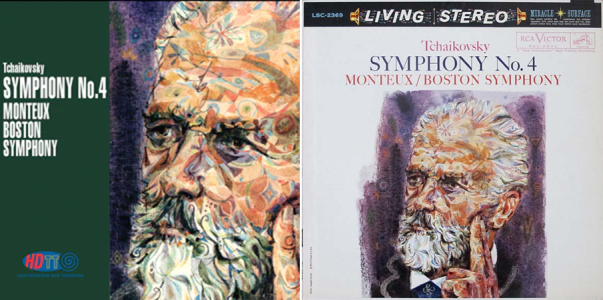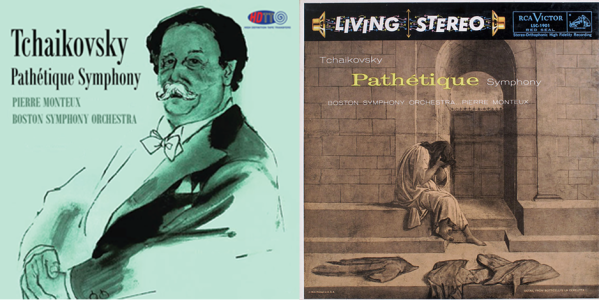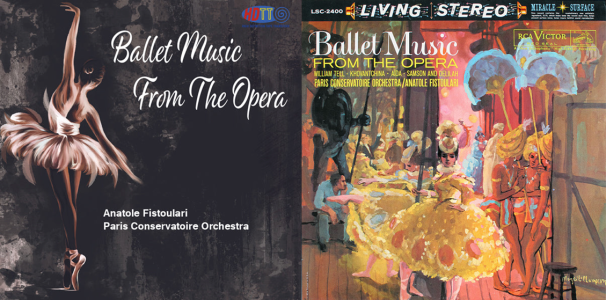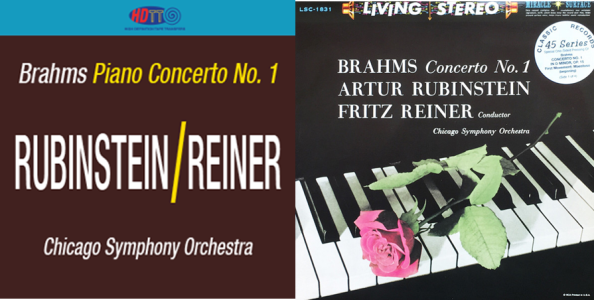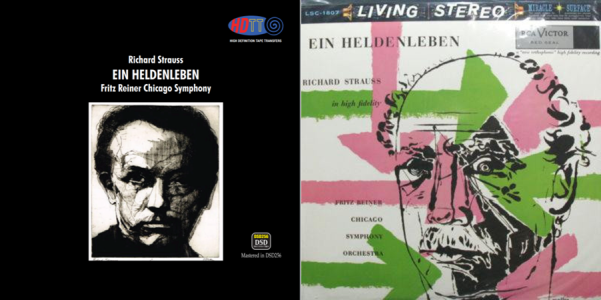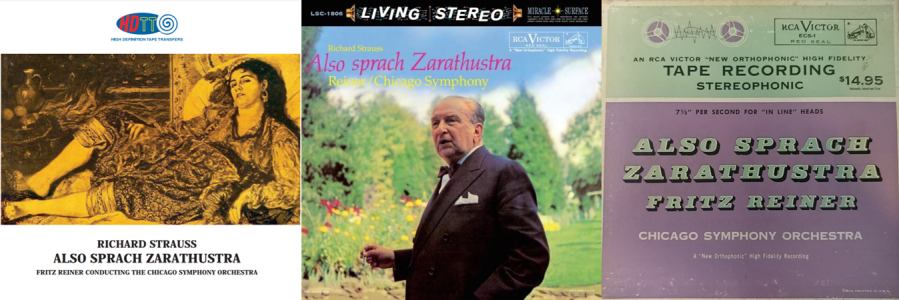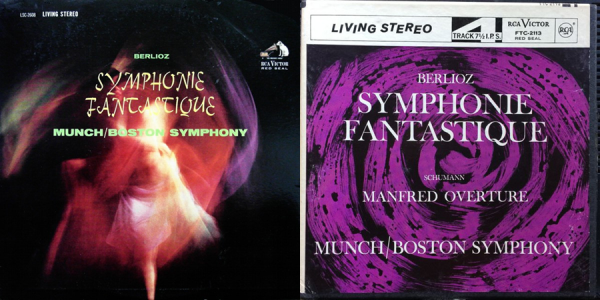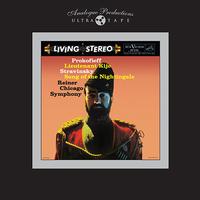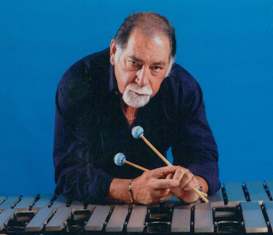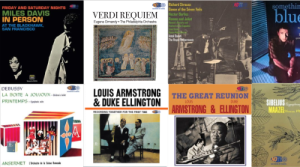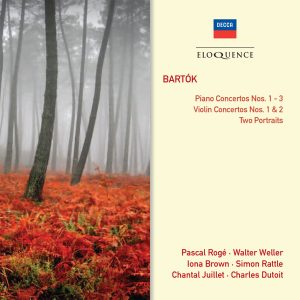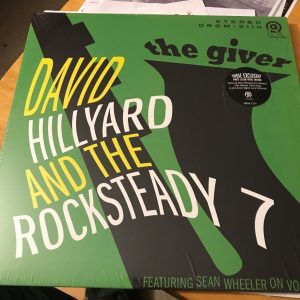Thus far in 2022, HDTT has given us three new and outstanding transfers of well known, and well loved, performances from the RCA Living Stereo catalog. To these, I've added several more of their excellent DXD/DSD256 Living Stereo reissues, plus a final reissue that RCA never released as a Living Stereo, but should have. They are all excellent. And, these HDTT releases are now my references for these recordings.
Original RCA Living Stereo covers above. HDTT covers are shown below with each album.
- Bartók Music For Strings, Percussion And Celesta - Fritz Reiner, CSO (Pure DSD256)
- Tchaikovsky Violin Concerto - Jascha Heifetz, Fritz Reiner, Chicago Symphony
- Gershwin Rhapsody in Blue/An American in Paris - Arthur Fiedler, Boston Pops
- Debussy Ibéria & Ravel - Fritz Reiner, Chicago Symphony Orchestra
- Heifetz, Primrose & Piatigorsky Play Beethoven, Schubert & Bach
- Lalo Symphonie Espagnole - Henryk Szeryng, Walter Hendl, Chicago Symphony
- Tchaikovsky Symphony No. 4 - Pierre Monteux, Boston Symphony Orchestra
- Tchaikovsky Symphony No. 6 "Pathetique" - Pierre Monteux, Boston Symphony
- Music from the Opera - Anatole Fistoulari, Paris Conservatoire Orchestra
- Brahms Piano Concerto No. 1 - Arthur Rubinstein, Fritz Reiner, Chicago Symphony
- Richard Strauss Ein Heldenleben - Fritz Reiner, Chicago Symphony Orchestra
- Richard Strauss Also Sprach Zarathustra - Fritz Reiner, Chicago Symphony (the 1954 recording)
- Berlioz Symphonie Fantastique - Charles Munch, Boston Symphony Orchestra (the 1954 and 1962 recordings)
- Beethoven Symphony No. 5 and No. 7 - Fritz Reiner, CSO
- Some final thoughts on DXD and DSD comparisons
For reviews of more RCA Living Stereo releases from HDTT, see my earlier article: The RCA Living Stereo Recordings by Lewis Layton at HDTT.
Bartók Music For Strings, Percussion & Celesta & Hungarian Sketches, Fritz Reiner, Chicago Symphony Orchestra. HDTT 1958, 2018 (Pure DSD256) HERE
L-R: HDTT cover, original RCA Living Stereo cover, CD/SACD reissue cover
Another of the great Lewis Layton recordings for the RCA Living Stereo label. This recording of Bartók's Music For Strings, Percussion & Celesta has long been listed among the top recordings any audiophile might wish to add to one's classical music library. Recorded nearly 65 years ago, the sound quality still matches some of the best efforts in the catalog. And the performance by Reiner and the CSO has not been superseded, it is simply amazing, often stunning. The performance is simply the most gripping and visceral performance in the catalog of this classic.
This HDTT transfer in DSD256 also delivers the best sound quality of this recording that I've heard. As good as the 2004 RCA SACD was (and it presumably was sourced from the master tapes), this transfer by HDTT reveals layers of air, depth and texture that are simply missing from that release. And that SACD was miles better that the standard CD. If you like this music and you have any other digital release, you owe it to yourself to replace it with this Pure DSD256 release from HDTT. No other comes close to the stunningly transparent, impactful sonics you will hear on this release.
Do you not know this music? It was composed by Bartok in 1936 and is today perhaps the best known of his compositions. It was written for string instruments (violins, violas, cellos, double basses, and harp), percussion instruments (xylophone, snare drum, cymbals, tam-tam, bass drum, timpani, piano) and celesta. Not a full orchestra, but jiminy, it sure sounds like it when you hear it. The work embodies many of the contradictions that make Bartók’s compositions so fascinating. As one critic puts it, the work is both primitive and sophisticated, wild and controlled, serene and terrifying, serious and slapstick.
The orchestration calls for the strings to be separated left and right on stage, performing antiphonally to each other as two separate string orchestras. The percussion is in the center at the back. With this setup, the musical ideas seem to zoom around the stage. Reiner follows these seating instructions, and this is one reason his performance consistently finds me so engrossed in what is happening. And in this highly transparent transfer, the musical interaction is very clearly exposed and easy to follow.
If you're not yet sure where I stand in recommending this recording, know now: it is amazing and needs to be in your collection!
Tchaikovsky Violin Concerto, Jascha Heifetz, Fritz Reiner, Chicago Symphony Orchestra. RCA Living Stereo | HDTT 1957, 2022 [DSD256, DXD] HERE
HDTT cover on left, original RCA Living Stereo cover on right.
This album has long been one of the most revered of the RCA Living Stereo catalog, and for good reason. Heifetz and Reiner are totally in sync on this performance. And the sound captured by RCA master recording engineer Lewis Layton in Chicago's Orchestra Hall is simply top drawer. Yes, there are limitations to the 1957 sound, don't let anyone tell you otherwise. But the recording quality here nonetheless exceeds that of many (most?) modern recordings. And, for my money, there simply is not a better alternative to Fritz Reiner & Jascha Heifetz in this music. Nor a better orchestra than the CSO here performing at peak perfection.
This transfer has all the resolution, inner detail, and dynamics of the best of the issues of this recording that I've heard. And yes, that includes all of the special 180 gram vinyl reissues and the Living Stereo SACDs and CDs that I've had in my music collection. HDTT has worked some special magic transferring this recording from their tape source. The results are simply stunning in the DSD256 file to which I've been listening.
A note about the transfer: HDTT notes that this release was edited in DXD PCM from a DSD256 Master then the DXD edited master was used to generate the final DSD files using Merging Technologies Album Publishing. As I mentioned in another article, Bob Witrak is now typically transferring from tape to file using DSD256, then converting to DXD for post-processing as in this case. He says transferring in DSD256 simply sounds better even when he must still convert to DXD on those tapes that need a bit of post-processing to sound as good as possible.
Gershwin: Rhapsody in Blue, American in Paris, Arthur Fiedler, Boston Pops Orchestra, with Earl Wild, piano. RCA Living Stereo | HDTT 1960, 2022 [DXD] HERE
I have several different digital releases of this classic Lewis Layton recording in my library, including both the RCA and AP SACD reissues. Of the two SACDs, the AP release is clearly superior to the RCA. And, if you have the AP SACD, you may be happy to stay with it. The comparison to this new transfer from HDTT is very close.
But this HDTT DXD transfer clearly outclasses every other digital copy of this recording.
As compared to the AP SACD, over multiple listening sessions I find myself gravitating to this HDTT transfer by preference. The HDTT contains more of the harmonic overtones of the instruments. It simply has more bloom, depth and texture to the sound of the instruments and the orchestra overall. Also, there is none of the subtle compression that seem to plague both SACDs.
On the other hand, there is an undeniable clarity and openness to the AP SACD that the HDTT transfer misses in places, e.g., the final 30 seconds of the Rhapsody in Blue. But, that clarity is at the expense of the more natural sound of the HDTT.
In sum, on my system, and given my listening priorities, I find myself enjoying the sound from this HDTT transfer more than the SACD. (The CD doesn't merit comment.) This release will be the source I listen to in the future when I want to hear this music. If you have the AP SACD, you may be happy to stay with it. If you still have vinyl playback capacity, you certainly have the very fine AP vinyl reissue to enjoy. Otherwise, you really need to upgrade the digital reissue you're listening to with this excellent new transfer from HDTT.
Thank you, HDTT. Well done!
As to the performance and Lewis Layton recording, most of you will be familiar with it. It is one of the RCA Living Stereo classics and is widely known. But, for someone who may not be familiar with this recording, a few words might be helpful.
From the liner notes: "George Gershwin's Rhapsody in Blue, arguably the most popular work for piano and orchestra written by an American, came about almost by accident. Toward the end of 1923, popular bandleader Paul Whiteman asked Gershwin if he'd consider writing a jazz concerto for his orchestra. Gershwin informally agreed to do so and returned to his regular beat of writing songs for Broadway shows."
But then Whiteman announced that this "jazz concerto" would be premiered at a coming performance barely more than a month away. A collaborative effort hit high gear. Then as now, it was standard procedure for a Broadway composer to use an orchestrator, and arranger Ferde Grofé was then producing most of the Whiteman band's original arrangements and leading the rehearsals. Gershwin began work on the piece on January 7, 1924. It was done by February 4, 1924, when Grofé ordered the orchestral parts be made up in time for rehearsals.
The famous clarinet glissando that opens the work was improvised as a gag during rehearsals by Whiteman clarinetist Ross Gorman. Gershwin asked him to keep playing it that way.
The premiere was a huge success. Grofé created three more orchestrations of it—the first being a 21-part version for theater orchestra that became the standard text of the work for the next two decades. Grofé didn't create a version for full orchestra until 1942, and this is now the version that is most familiar and most frequently recorded.
An American in Paris premiered at Carnegie Hall on December 13, 1928. George and his brother, Ira, took a break from Broadway for a trip to Europe in March 1928. George Gershwin hoped to complete an orchestral work he had pondered since returning from a 1926 visit to Paris, when he had composed a fragment of music labeled “Very Parisienne” and entitled An American in Paris. Inspired by the sounds of taxi horns along the Paris boulevards, Gershwin and his friend Mabel Schirmer went shopping for those horns in the automobile shops along the Avenue de la Grande Armee and he returned home to incorporate them into this “rhapsodic ballet,” which was premiered in December. This is the work made famous in the 1951 Gene Kelly film of the same name.
This 1959 recording, released by RCA in 1960, was made by the RCA recording team of engineer Lewis Layton and producer Richard Mohr, one of the great recording partnerships from the golden age of stereo recording. I would have included this recording among my list of the great RCA Living Stereo recordings available from HDTT (HERE) had it been available at the time of writing that article.
Debussy Ibéria & Ravel, Fritz Reiner, Chicago Symphony Orchestra. HDTT 1957, 2022 (DSD256, DXD) HERE
This album has long been considered one of the top Living Stereo releases. Why? Let's just count the ways. It is rich in timbre and detail. It is beautifully transparent. One can readily locate instruments both across the stage and in depth. It is full of orchestral color and huge variety of instrumental sounds. The Chicago Symphony Orchestra's fabulous woodwind section simply shines. In Ibéria, the percussionists perform as a crack ensemble with lightening quick changes in dynamics, ranging from quiet delicacy to raw power. From the castanets to the different styles of tambourine technique, from the softest stroke of a soft mallet on suspended cymbal to the superb timpani sound, Ibéria is all that recorded percussion should be. The entire recording has precision, perfect ensemble, energy, life and impact. Need I go on?
More importantly, Reiner and his forces capture the atmosphere of Spain embedded in the music of Debussy and Ravel. It is that "authenticity" that makes this such a great recording. The execution by this conductor and orchestra is simply astonishing to me. And it is as exciting a performance of some truly excellent music as one might ever hope to hear.
And, for clarity, let's not confuse this work with Albeniz's Ibéria, a suite for piano generally considered his best work. This Debussy orchestral Ibéria is the second of three pieces Debussy composed between 1905 and 1912 that are included in the set titled Images pour Orchestre. The other two pieces being Gigues and Rondes de printemps. Ibéria itself is in three movements.
So, how does this digital transfer sound? In a word: glorious. This HDTT reissue is open, transparent, highly detailed, and with full frequency extension in both bass and treble. Dynamics are terrific. An excellent outing by HDTT.
Heifetz, Primrose & Piatigorsky Play Beethoven, Schubert & Bach. HDTT 1960, 2022 (DSD256, DXD) HERE
I remember the original Shaded Dog LP, and an even better sounding White Dog LP, both of which once graced my music shelves. Neither ever sounded as good as this DSD256/DXD release. This release brings a new openness and transparency to the sound that finally gives full justice to these marvelous performances. It also opens up the inner details to hear more of the sound of bow on strings, the harmonic overtones, the precise attack. Beautifully balanced with excellent reproduction of timbre, this is wonderfully satisfying new release. The music was there on the tapes all this time. It just took an exceptionally skilled engineer (Bob Witrak) to pull the sound off the tapes, sprinkle a bit of magic fairy dust in some judicious post processing, and carefully deliver to us the music fully undamaged in the transference. A delight to hear!
Lalo Symphonie espagnole, Henryk Szeryng Violin, Chicago Symphony Conducted By Walter Hendl. HDTT recorded 1959, 1961, 2016 (DXD) HERE
Despite its title, Lalo’s Symphonie espagnole is essentially a violin concerto, not a symphony. And it's a violin virtuosic showpiece that needs excitement and color to make its best effect. And Szeryng delivers this in spades. In this brilliant performance, Szeryng sparkles with style and power. He is virtuosic and stylistically alert. With all five movements presented, it is one of my favorite performances of this work.
The CSO and Walter Hendl do even much more to bring out the piquant Spanish colors of the score with their elegantly lucid performance , The Symphonie Espagnole may not be great music, but it is tremendously entertaining and unbeatably appealing when performed like it is here.
Couple these excellent performances with the sonics of orchestra hall and the excellent recording from producer John Pfeiffer and recording engineer John Crawford and you have here one of the top RCA Living Stereo releases. The transfer by HDTT from an RCA 2-track 15ips tape is excellent.
Though French-born, Lalo was of Spanish descent. Accordingly, he wrote his Symphonie espagnole with Spanish motifs throughout. Many musicologists agree that it helped to launch a period when Spanish-themed music, often written by French composers, became common.
Tchaikovsky Symphony No. 4, Pierre Monteux, Boston Symphony Orchestra. HDTT 1959, 2016 (DXD) HERE
One will hear many recordings of Tchaikovsky's symphonies. Many drip with pathos and over-sentimentality. Not here. Monteux is straightforward, and that is what makes his recordings of Tchaikovsky work so well. Mravinsky's Leningrad recordings from the 1960's probably take precedence for me, but none are available in the sound quality that RCA captured in this 1959 recording in Symphony Hall and none are available in the high resolution of this HDTT transfer.
Monteux's interpretation is electrifying. Monteux is able to convey all at once subtlety, refinement, passion and spontaneity. Each time I listen to this recording, it is as though I'm hearing the music for the first time. This performance is just "alive." Nothing tormented, not tortured, as this piece is so often played. The Finale is played with full out conviction and dynamic drive—con fuoco it is! You can almost feel the orchestra gasp breath as the final notes fade. It is a recording for the ages.
HDTT's transfer is as detailed and resolving as we've come to expect, with excellent low level detail and very low noise floor.
Tchaikovsky Symphony No. 6 "Pathetique", Pierre Monteux, Boston Symphony Orchestra. HDTT 1955, 2022 (DXD) HERE
This is one of those orchestral works that truly benefits from being able to hear all of the subtle low level details—hearing into the orchestra, as it were. And this transfer from HDTT superbly supports that. From the very opening, which is so quiet, this release is clear, detailed and transparently resolving. The inner detail one hears in this recording is simply ravishing. Unlike the RCA CD and SACD versions, the dynamic range has not been compressed with the quiet passages boosted. This is full dynamic range from pppp to ffff. And the power of the full orchestra is cleanly captured. No worries about the clarity and resolution in the climaxes. It's all here.
This may be my favorite Pathetique, even surpassing my admiration for the 1961 Mravinsky recording with the Leningrad Symphony (also available from HDTT in a Pure DSD256 transfer HERE).
The great RCA recording engineer Lewis Layton has Symphony Hall managed to tame Symphony Hall for a recording of great breadth, depth and resolution (but with a bit less center-fill than one might wish for). It is not the sonic equal of the results he was soon to achieve in Chicago's Orchestral Hall, but given the challenges of the state in Boston, this is quite sonically pleasing. That this result was achieved in 1955 is astonishing.
Unfortunately, many of the reissues over the years have been indifferently mastered and I've struggled to find a really good sounding digital reissue. The CDs are just not good, and the SACD okay but not great. That difficulty is now solved in this new transfer from HDTT. With this reissue, we finally have this superb recording sounding better it ever has.
Music from the Opera, Anatole Fistoulari, Paris Conservatoire Orchestra. HDTT 1958, 2022 (DSD256, DXD) HERE
This recording is another Kenneth Wilkinson engineered masterpiece of orchestral recording skill. The sound has all of Wilkinson's renowned inner detail, clarity and depth, with well-defined bass. The music is lively and engaging in typical Fistoulari fashion. Overall the works selected are on the fluffy side, but they do dance and shimmer with engaging grace. Fistoulari drives the music along in crisp fashion, and the musicians of the Paris Conservatoire Orchestra respond brilliantly. It doesn't achieve "top of the pile" status for me only because some of the bass drum impact goes a bit "bloomy" without that crisp definition that is heard in other Decca engineered recordings - a tape artifact, perhaps? But, altogether it's a very enjoyable listening experience with this excellent sounding transfer by HDTT.
Brahms Piano Concerto No. 1, Arthur Rubinstein, Fritz Reiner, Chicago Symphony. HDTT 1954, 2021 (DXD) HERE
HDTT cover on left, Classic Records 45rpm reissue (which is seriously good) on the right using the mono LP release artwork.
This is Brahms with bravura and panache. It is a performance I've played over and over for years. It is powerful, nuanced, and extremely well recorded. This continues to be one of the best performances and recordings of this work in the catalog, notwithstanding that it was recorded almost 70 years ago.
The piano is recorded very closely, the sound of the strings is occasionally a bit "scrappy", and it may lack the ultimate transparency of the best modern orchestral recordings (e.g., those by Jared Sacks or Bert van der Wolf), but the overall experience is still an excellent and realistic rendering of the musicians on stage.
And you simply can't beat the performance. I have, at last count, 13 different performances of this work and this performance with Rubinstein, Reiner and the CSO is my decided favorite. The volatile Rubinstein/Reiner Brahmsian chemistry holds its own against all others.
Of interest (at least to me) is that Reiner had the Chicago Symphony strings in the older European seating plan for this performance: first violins on the left, second violins on the right, and the basses on the left. The recording captures this very well. The following season, he had the strings adopt the "American" seating plan used by most orchestras today, with both violin sections to the left and basses to the right.
The HDTT transfer in high definition makes this the best sounding digital reissue of this recording in my music library. The HDTT transfer improves upon the RCA Living Stereo SACD release I have—there is greater dynamic range (the SACD sounds compressed by comparison even though it is mastered at a louder level, so be careful making comparisons) and the HDTT has better reproduction of the timbre of the instruments. It simply has more of the truth of good analog sound to it. The various CD reissues are simply not competitive. If you enjoy this performance, just get this HDTT transfer and luxuriate in the improved sound. You won't regret it.
Richard Strauss Ein Heldenleben, Fritz Reiner, Chicago Symphony Orchestra. HDTT 1954, 2019 (Pure DSD256) HERE
Left to right: HDTT cover, original RCA Living Stereo cover
This famous recording of Ein Heldenleben was made by RCA on March 6, 1954, just two days before recording Also sprach Zarathustra (below). The brass section of the CSO in this period was one of the greatest brass sections ever assembled. And lead trumpet, Bud Herseth, was perhaps the finest orchestral trumpet player we've seen. He simply soars through Ein Heldenleben with exuberance, deftness, lyricism, and majestic power. But the entire brass section plays as ONE—simply superb.
This work benefits in particular from Reiner's taut and unsentimental approach. Coupled with the outstanding playing of the Chicago orchestra, this performance is indispensable and deserves to be in any music library. The HDTT transfer is, once again, excellent. As to comparisons to other digital releases, including the SACD, see my comments under Also sprach Zarathustra below.
Richard Strauss Also sprach Zarathustra, Fritz Reiner, Chicago Symphony Orchestra (1954 Recording). HDTT 2019 (DXD) HERE
This is perhaps the greatest performance of Also sprach Zarathustra in the catalog. Reiner and Chicago roll on almost without letup, with immense impact. As Steve Schwartz writes on Classical.net, "This is one of the few recordings that treats the piece as a symphonic construction, rather than as a movie theme with an inexplicably long half-hour addendum." Reiner recorded this work in stereo twice for RCA, once in 1954 and again in 1963. This 1954 recording is without question the better performance. And the recording quality stands up to some of the best recordings being made today.
HDTT's transfer to DXD gives us a superb reissue transferred from the RCA Victor Red Seal 2-track tape #ECS-1. The first stereo reel to reel tape released by RCA. Recorded on March 8, 1954 at Orchestra Hall, RCA used their "B Team" of producer John Pfeiffer and recording engineer Leslie Chase. Lewis Layton was still on the monophonic "A Team" because, at this time, monophonic was still the major money-maker for RCA and stereo was "experimental." But what a glorious experimental recording this is.
The quality of the recording led RCA to include Richard Mohr and Lewis Layton on future recordings with the orchestra.
So, how does the SACD compare to this HDTT release? Regrettably, in comparison, the SACD sounds stripped down, lacking in depth, texture and impact. The SACD sounds clear and open, but it is simply anemic by comparison to this HDTT transfer. If you have the SACD, you will be be very pleased by the upgrade to the HDTT.
Berlioz Symphonie Fantastique, Charles Munch, Boston Symphony Orchestra (the 1954 recording). HDTT 1954, 2019 (Pure DSD256) HERE
The 1954-56 covers. L-R: Original mono cover, alternate U.S. mono cover, stereo tape cover
Charles Munch recorded the Symphonie Fantastique twice for RCA, both in stereo: 1954 and 1962. The 1954 recording was released on a mono LP with the cover design shown above. A stereo release of that 1954 performance followed on reel-to-reel tape in 1956, but the stereo release on LP came only belatedly on the Red Seal and Gold Seal labels.
To utterly confuse matters, Classic Records tagged the 1954 performance "Living Stereo" in its reissues beginning the the 1990s, and RCA followed this labeling in the CD and SACD era.
L-R: Classic Records 45rpm cover, RCA CD cover, RCA SACD cover, all the 1954 performance
So, why no RCA Living Stereo LP release? Because Munch re-recorded the work in 1962 and it was that new performance that RCA released under the Living Stereo banner.
Berlioz Symphonie Fantastique, Charles Munch, Boston Symphony Orchestra (the 1962 recording). HDTT 1962, 2020 (DXD) HERE
L-R: Original Living Stereo release of 1962 performance on LP and on reel-to-reel tape
So, faced with choosing one or the other performance, which does one choose? Both performances are excellent, both have their adherents. In some venues, the merits of one versus the other are hotly contested.
But for me, there is no contest. The 1954 is the more intense, more powerful performance. The bells in the final movement strike utter fear. This 1954 Boston Symphony Orchestra recording is among the finest I know at this defining moment. The low brass is thunderous and menacing. The entire performance has a tensile strength and drive to it that the 1962 performance simply misses. On the other hand, the 1962 performance brings out more of the lyricism, the ruminative beauty, of several segments. But I simply have to go with the shear driving terror that builds throughout the 1954 performance.
Either of the HDTT releases easily surpass every other digital release of these performances that I have in my library. Both are highly recommended, but my hat is off to the 1954.
Beethoven Symphony No. 5 & No. 7, Fritz Reiner, Chicago Symphony Orchestra. HDTT 1959, 2020 (DXD) HERE
These are majestic performances of the old school, played superbly and in excellent recorded sound quality. Reiner does not overdrive the Fifth as do many conductors. He allows it to breathe. There is majesty in his held chords. Many of us rightly revere Eric Kleiber's 1953 Concertegbouw recording of the Fifth (engineered by Kenneth Wilkinson for Decca), and then also his son Carlos Kleiber's recordings of the Fifth and Seventh on DGG from 1975-76. You need those recordings. But Reiner's performances are fully competitive and different enough in interpretive approach that they deserve to be heard—they are excellent. Some will hold them in yet higher regard than those of father and son Kleiber. The sound quality is certainly better. RCA's master recording engineer Lewis Layton by this time has the quirks of Orchestra Hall well in hand. And his recording of these two symphonies captures the power of the great Chicago orchestra with full dynamics, thunderous bass and great clarity.
HDTT's transfer is clean, transparent, highly resolving, and with a very low noise floor. Unfortunately, the Fidelio Overture is not included on this release. Overall, enthusiastically recommended!
For some of the albums above, I compare a DXD transfer to the DSD64 SACD. This is not as a commentary on DXD versus DSD. I make the comparison only because these are the best of the various digital transfers of this recording that I have available to me. They simply happen to be in different formats. For me, it's all about finding the best (digital) sound in which this album is available, not any sort of digital format contest.
As to format comparisons, from what I hear of HDTT's releases, their Pure DSD256 transfers are the most transparent. So I eagerly look for those releases. In this case, I presume the source tape required a bit of work in post that would not have been possible in a Pure DSD transfer.
For a further discussion about the various formats, you might find of interest an earlier article: Pure DSD256 - What We Hear.
Where some of the albums above had DSD128 releases, I only listened to the DXD release because it is the edit master from which the DSD128 was derived. From other listening comparisons I've made using my Playback Designs MPD-8 DAC, I'm happy to let my DAC handle the processing from the edit master without another conversion step being involved. With another DAC (e.g., the Teac DAC used in our office system), the sound quality might be better from a DSD file that was converted offline, using more time and greater computer processing power, than stressing the DAC or audio server to make the conversion on-the-fly. Point being, be sure to do your own listening comparisons and find out what source files will give you the best sound quality in your system.
Now that Bob is making his tape transfers to DSD256 even when he will do some post-processing in DXD, I've changed my habits. In these releases, I am typically listening to his final DSD256 published from the DXD edit master. I'm finding that these typically do sound better than the DXD for these albums. Again, your mileage may vary.




